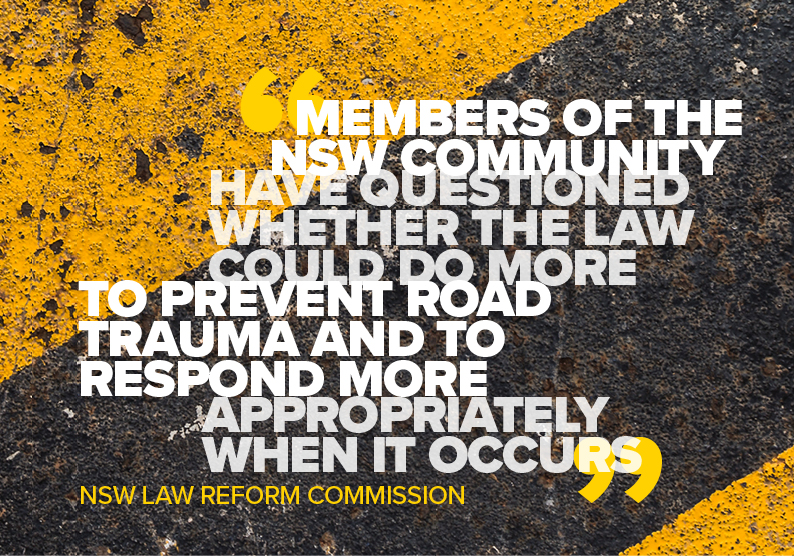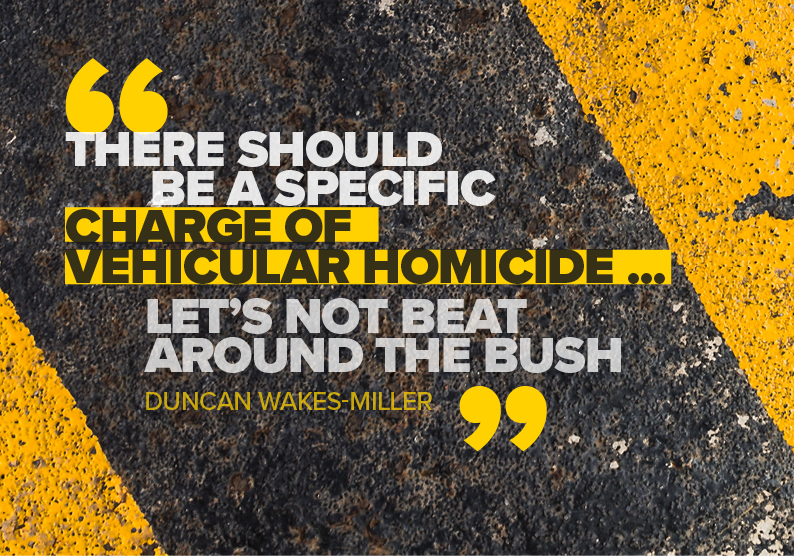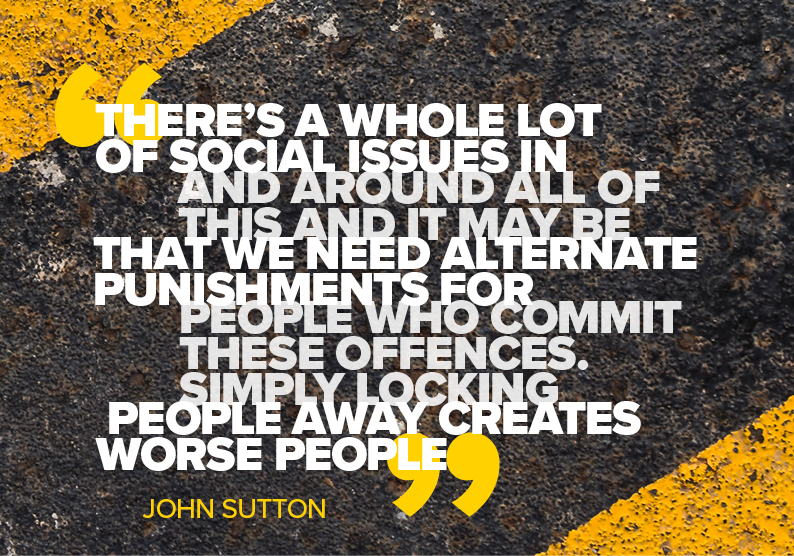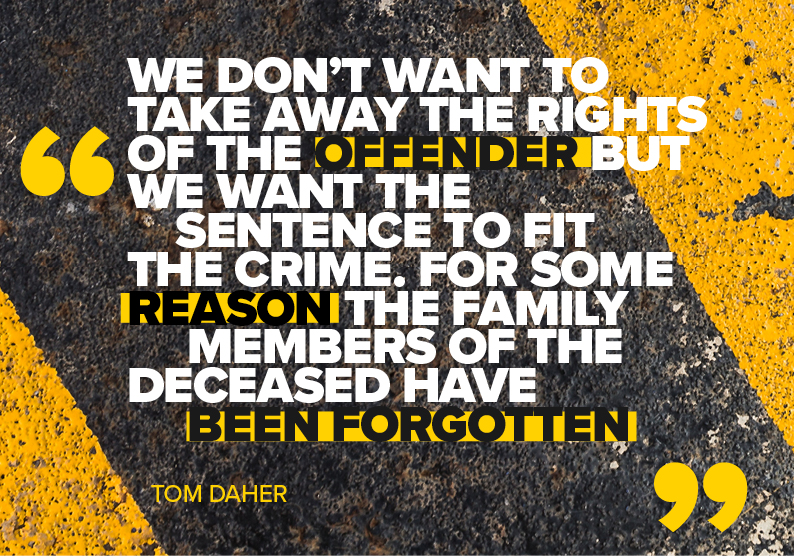“I see the law hamstringing itself from a prosecutorial position by creating specific offences, creating more grey”
Road trauma is a devastating reality across Australia, but is the law doing enough to prevent it happening and appropriately dealing with its aftermath? A major review of serious road crime in NSW is trying to find answers.
It was the middle of the night when Duncan Wakes-Miller and his family were woken. Police had come to their home in July 2020 to inform them that 17-year-old Barney Wakes-Miller had been killed in a crash. He was a passenger in a car that was being driven by a drunk driver, when it hit a fence while speeding at Elanora Heights on Sydney’s Northern Beaches.
The driver, who cannot be named because he was a juvenile at the time, pleaded guilty to dangerous driving (under the influence of alcohol) occasioning death and received a 21-month good behaviour bond in the Children’s Court. The sentence was appealed by the DPP but the District Court dismissed the appeal and the original sentence stood.
Barney was in year 11 at St Augustine’s College in Brookvale, where he was a prolific artist. “He was a larger-than-life character, loved by a lot of his friends,” his father tells the Journal. “He was a brilliant kid, I loved him very much and there’s a lot of people who really miss him.”
Like so many other people affected by road trauma, Wakes-Miller found himself foisted into the unfamiliar world of the criminal justice system. He remains bitterly disappointed with the outcome of the case against the driver but has directed much of his energy towards advocacy.
He helped form the Road Trauma Support Group (RTSG), because there was a lack of specialist support services for people impacted by serious road crime, a problem that was acknowledged by police.
Are the current laws fit for purpose?
How the law deals with offenders and victims of this type of crime is the subject of a review by the NSW Law Reform Commission. Many questions are being asked, including whether existing offences are fit for purpose.
In its discussion paper, the commission says, “Members of the NSW community have questioned whether the law could do more to prevent road trauma and to respond more appropriately when it occurs.” The review was ordered by then Attorney General, now Opposition Leader Mark Speakman, in November 2022.
Among the questions being considered by the LRC is whether a new offence of ‘vehicular manslaughter’ or ‘vehicular homicide’ should be created in NSW. Supporters of this idea argue it would better reflect the seriousness and consequences of the crime and send a stronger message that society will not tolerate such actions.
“There should be a specific charge of vehicular homicide and that should be the apex of this and work back from there,” says Wakes-Miller. “But this is homicide. Let’s not beat around the bush here. It’s vehicular homicide.”
In its consultation paper, the commission says for the period between 2016 and 2022, it identified 26 proven court appearances for manslaughter, that could be described as vehicular manslaughter. All but one, which saw the person detained in a mental health facility, resulted in terms of imprisonment. The average head sentence was nine years and two months at first instance.
John Sutton is an Accredited Specialist in criminal law and a Director and Principal of J Sutton Associates in Sydney, which he established in 2020. He is also a member of the Law Society’s Criminal Law Committee. Sutton does not see the need for major reform in this area of law, including for the offence of manslaughter.
“How you commit that offence is a matter of factual circumstance,” he explains to the Journal. “I am a great believer in not creating specific or nominated offences… if we’ve already got law there that justifies it,” he says.
Sutton believes doing so runs the risk of having other consequences. “If anything, I see the law hamstringing itself from a prosecutorial position by creating specific offences, creating more grey,” he says.
In its substantive submission to the review, the Law Society says the change is not necessary. “There does not appear to be evidence to suggest that the existing manslaughter offence is not operating effectively, or otherwise being inappropriately used, that may warrant consideration of legislative change,” it says.
Principal Solicitor at Streeton Lawyers, Justin Wong, also sits on the Criminal Law Committee and says the existing framework does not need to be changed. “The current offence of manslaughter already encompasses a significant degree of gross levels of negligence, and it has been used where appropriate in the past,” he says.
Dr Kerry King is the author of A Lesser Species of Homicide: Death, Drivers and the Law, which was published in 2020. It chronicles how parliaments, prosecutors, police and courts have treated road crashes causing death, dating back to the 1940s, with a focus on Western Australia. It traces reform in this area of law and the impact of high-profile cases.

In the book’s conclusion, King writes, “For a complex set of reasons, legal and social, drivers brought before the courts have been the beneficiaries of tremendous leniency. There is little reason to believe this to be some peculiar Western Australian phenomenon.”
Asked about the prospect of a new vehicular manslaughter offence, she tells the Journal the suggestion is misguided and what is really needed is for more drivers to be charged with the existing offence of manslaughter by criminal negligence, which she says is plainly fit for purpose.
“In all Australian jurisdictions, there has been a widespread excessive reliance on driving causing death offences,” she says. King observes that, “manslaughter requires a great or gross falling short of the standard of care which a reasonable or ordinary prudent driver would exercise, which is so high that it is foreseeable that death or grievous bodily harm would follow.”
King says driving down the wrong side of the road at speed, for example, might be seen to satisfy this threshold. “Yet, somehow the threshold of grossly falling short has been set extraordinarily high,” she says.
Tougher sentences, greater deterrence?
A number of preliminary submissions to the review said tougher penalties were needed, so they acted as a greater deterrent to this type of crime. But even the notion of general deterrence, is largely a myth, in Sutton’s view.
“The thought that somebody is, in the throes of a highly charged incident, going to think about the consequences of what they’re doing … it just does not ring true to me.” Harsher penalties would not have the impact proponents are seeking, according to Sutton.
“I don’t honestly believe that it will change, from a preventative point of view, anything at all,” he says. Wong adds that increasing sentences would have serious consequences.
“So if there’s a situation where someone previously would have avoided custody but still received a significant penalty, say an Intensive Corrections Order but in this case, because of the increase in maximum penalties they’re going to receive a full-time custodial sentence, that has all kinds of run-on effects for them later on,” he says.
“The question then becomes, is that acting as greater general deterrence in the community? I think that’s questionable whether it does.”
Wakes-Miller says the problems go beyond sentencing. “[I]t’s not just about sending people to prison, because no one really wants to fill our prisons,” he says. “What we do want is… a punishment system which provides a deterrent and a rehabilitation program that gets people back on the straight and narrow and doing the right things.”
To King, the fear of getting caught does have an impact on driver behaviour. She says investing in policing, including random breath tests, mobile phone use detection and measures to detect speeding, has dramatic results. “Continuing to revise the penalties for these offences and actively policing them sends a clear message about risk-taking behaviours and the possible catastrophic consequences,” she says.
When handing down sentences for dangerous driving in NSW, courts are required to consider the guideline judgment R v Whyte. The LRC has noted guideline judgments are aimed at promoting consistency and maintaining public confidence.
“[I]t tries to give courts an idea of the parity of sentences, so the ballpark line of where sentences should be,” says Sutton. Average head sentences for dangerous driving occasioning death have been around three years since Whyte, which is consistent with the guideline.
The judgment is more than 20 years old, and some victims’ groups believe it is inadequate and overly lenient. The guidelines in Whyte describe a typical case involving a young offender with no or limited prior convictions.
The LRC has questioned whether these features could still be seen as typical, noting that almost half of dangerous drivers in the four years to December 2022, had a criminal record. 32 per cent of offenders were under the age of 25.
But to Sutton, the guideline judgment remains as relevant as when it was written. “I don’t see a life or a maiming that occurred 20 years ago being worth any more or any less than a life or a maiming that occurs today,” he says.
Serious road crimes currently fall under the Crimes Act 1900. Some preliminary submissions to the review suggested a separate Act, specifically for serious road crimes. For Wakes-Miller, a singular framework would streamline legal processes and ensure consistency and fairness.
“[T]he legislation is simply not fit for purpose,” he says. “The current offences for road crime are not effective.” Again, the Law Society does not support a new Act, saying in its submission that it would be a “… complex and largely unnecessary endeavour …”
The benefit of keeping the offences in the Crimes Act, according to the submission, is that the general principles of the Act, such as the provisions about criminal responsibility, automatically apply.
The public debate about sentencing is one thing, but is there an underlying ambivalence about this category of crime in some sections of the community? Wakes-Miller argues a serious change in mindset is needed about the “social unacceptability of dangerous driving.”
“When it comes down to it, if someone is killed in a car, they are killed by a lethal weapon – a lethal weapon that is like a gun or a club or a punch and yet it seems that if you’re killed by a car, it’s A Lesser Species of Homicide,” says Wakes-Miller, in reference to King’s book title.
He points to law reforms including gun control, the use of seatbelts, domestic violence and consent, to argue there is a way forward. “[W]e’ve got a litany of examples of where social attitudes have changed, sometimes overnight,” he says.
 John Sutton
John Sutton
For many road trauma victims, the use of the word ‘accident’ is particularly rankling. “I think because everyone drives, everyone thinks ‘that could be me, I could make that mistake, I could make that accident,’” says Wakes-Miller.
“But to use the word accident is really underplaying it. An accident is a poor description with an excuse written in. I wouldn’t describe the death of my son like someone spilling milk on the kitchen table.”
The RTSG has issued a set of guidelines for the reporting of road trauma in the media. The guidelines say use of the word ‘accident’, “risks making criminal crashes seem inevitable and unavoidable.” Media organisations are also encouraged to show discretion with graphic images and footage, and to avoid sensationalist language.
Sutton argues the vast majority of cases are absent of one crucial element. “If someone gets into a car after drinking or taking drugs or whatever, yes, they intend to get into the car, yes, they intend to drive it, probably for their own convenience in reality. But I would warrant on 99.99 per cent of the time, they think they’re just going to get home, or get to wherever they’re going. They’re not getting in there with the intention of hurting someone.”
Historical context of attitudes to driving offences
If deaths involving motor vehicles are treated differently, how did that come to be the case? King draws the analogy of tumbleweed amassing over time. She says this has had the effect of “entrenching prosecutorial approaches and community sentiments, some of those with the best intentions of legislators.”
King retraces this journey to the middle of the twentieth century. “The community’s indifference to, or tacit acceptance of risk-taking behaviours that were a major factor in crash causation, most particularly drinking and driving, presented a significant obstacle to convictions,” she says.
King argues that in more recent decades, legal amendments have been cobbled together, without dealing with the underlying structural issues at play. “Prescribed circumstances of aggravation have created a fine line, if any, between aggravated dangerous driving and manslaughter, shoring up manslaughter’s marginalisation,” says King.
The retraumatising impact of the criminal justice system
Living through the often-protracted court process can be retraumatising for victims. It was for Tom Daher, whose father Tannous Daher was killed by a drug affected truck driver at Merrylands in Sydney’s west in July 2017.
The 83-year-old had been gardening on the footpath with his brother-in-law when they were hit by a truck. The driver, Moustaffa Zreika’s licence was suspended at the time and a blood sample revealed the presence of a number of drugs, including high levels of the opioid pain medication, tramadol.
On appeal, he was sentenced to a non-parole period of three years and eight months in prison. A jury had found Zreika guilty of dangerous driving occasioning death and dangerous driving occasioning grievous bodily harm.
The court process left Daher with a firm view that the justice system is not there for victims. He tells the Journal, no one forewarns victims of when an accused person will actually attend court, during the series of mentions that precede a trial.
The experience of being in the courtroom can also be unnecessarily distressing. “We’re forced to sit side by side with the family members of the offender. No consideration is given to the families of the deceased, you know, where room is allocated. We’re all put in there together,” he says.
The experience motivated Daher to help set up the Road Trauma Support Group in 2021. “With the assistance of the NSW Police, we put together a group. Family members who had been affected by road trauma came together, met at the police headquarters and from that very first meeting, you could see that people were traumatised.
“People had nowhere to go… no idea of what they should do,” he says. “Sadly, our membership grows and it’s not what we want but we are there to help people pick up the pieces and continue living.”
351 people were killed on the state’s roads in 2023, a figure widely seen as alarming, as it represented a 25 per cent increase in deaths on the previous year. The NSW Government convened a road safety forum in February, bringing together experts from around Australia and overseas, as well as motoring and victim advocates, reflecting the heightened community concern about road trauma.

Of the 70 additional deaths last year, 53 occurred in country areas, despite just a third of the population living in these areas. And the deaths do not account for the more than 10,000 people seriously injured in crashes.
There are times when young people are responsible for serious road crimes and in general, they receive more lenient sentences. The Children (Criminal Proceedings) Act 1987 (NSW) sets out principles focussed on reintegration and rehabilitation.
One option mentioned by the LRC is expanding the list of serious children’s indictable offences to include aggravated dangerous driving occasioning death and grievous bodily harm and dangerous driving occasioning death and grievous bodily harm. This would mean the offences would always be dealt with in the higher courts, rather than the Children’s Court.
To John Sutton, many offences involving young people are linked to the development of the brain. “And so you’ve got a lot of very stupid children doing very stupid things and no doubt they are criminal but the place for them to be dealt with, that has the best chance of not creating a career criminal, is the Children’s Court. It’s why it exists,” he says.
“There’s a whole lot of social issues in and around all of this and it may be that we need alternate punishments for people who commit these offences. Simply locking people away creates worse people.”
In recent years, one particular crash in Western Australia made legal history. In 2020, a drug-affected driver who killed a motorcyclist in suburban Perth the year before, was sentenced to life imprisonment, with a non-parole period of 13 years, after pleading guilty to murder. Kylee King became the first driver in Australia to be convicted of felony murder. King (no relation to Kerry King) was initially charged with manslaughter, but the charge was upgraded to murder.
In Western Australia, felony murder can apply when someone is killed by an act in the prosecution of an unlawful purpose, where the act is likely to endanger human life. The prosecution does not have to establish an intention to kill or cause serious injury. Felony or constructive murder exists under state laws across the country, but not in the NT, the ACT or under Commonwealth law.
Kylee King was driving a car with stolen number plates and had led police on a series of pursuits over a 40-minute period, at times reaching speeds of more than 140km/h. She failed to stop at stop signs and red lights and repeatedly crossed onto the wrong side of the road, before colliding head on with a motorbike in the suburb of Welshpool, killing its young rider.
The sentencing judge found King was deliberately driving on the wrong side of the road to evade police and prevent her arrest. At the time, Kerry King remarked in the Criminal Law Journal that the case may have “tremendous potential” to reframe perceptions of culpable fault and lift charging standards across Australia.
Is there another way to give victims what they are seeking?
Another aspect of the Law Reform Commission’s review is the potential of restorative justice to support people harmed by road trauma and whether it should be expanded in NSW. Restorative justice refers to processes aimed at addressing needs not met by traditional courts.
In its restorative justice program, Corrective Services NSW gives victims and offenders the opportunity to communicate about a crime and its impact. Its service occurs after a sentence is handed down and can take a range of forms, including face-to-face meetings or indirect communication through facilitators. The capacity of the service is limited.
Stan Winford is Associate Director of the Centre for Innovative Justice (CIJ) at RMIT University. The CIJ conducted a pilot restorative justice program specifically for those affected by road crimes causing death or serious injury.
Winford tells the Journal the suddenness and violent nature of a serious collision often compounds the harm and loss involved. “I think some of the research on grief in this context has indicated that for some family members it can be senseless and meaningless, irrational. A preventable death that should not have happened,” he says.
 Justin Wong
Justin Wong
“The current offence of manslaughter already encompasses a significant degree of gross levels of negligence”
Although the impact on victims is considered in sentencing, the criminal justice system is largely focussed on the actions of an accused person. As the CIJ noted in its preliminary submission to the LRC review, culpability can sometimes be relatively low, resulting in a sentence that people find difficult to reconcile with what they have been through.
“The other unique context here is that although the harm is almost always really serious, that is, someone dying or being seriously injured, the legal response isn’t always symbolically equivalent,” says Winford.
Those involved in restorative justice concede it is not part of the mainstream in Australia. “One really simple way of describing it is that it can be a safe, supported conversation or dialogue between someone who’s experienced harm and people who might be responsible for that harm,” says Winford.
“It’s a process that involves everyone with a stake in what’s occurred, bringing them together to find ways of addressing the harm that’s been experienced,” he says.
Winford recalls the case of a woman whose daughter was killed in a crash, where the daughter’s boyfriend was driving. He was convicted of culpable driving. Winford says the mother wanted the opportunity to meet with the driver face-to-face, so she could ask if he had stayed with her daughter when she died.
The meeting did happen, and the driver confirmed he was with her. “That information is just so important for people to help resolve questions that they have and they’re not always legally relevant,” says Winford.
Role of victim impact statements
Victims already have the opportunity to participate in the court process through victim impact statements, where they can express the harm they have suffered due to a crime. They are tendered after an offender has been convicted and can be read in court by a victim or a representative.
Victim impact statements must be considered by the sentencing court and can be used to establish an offence has caused substantial harm, which is an aggravating factor for the purpose of sentencing.
Winford says victim impact statements can be healing and important, because they represent the need for people to have a voice in the criminal justice process. But he says there are limitations to what they can achieve. “People sometimes also want to have more than a voice, which is to hear back from the person responsible.” And he says the rules applying to these statements can also cause tension for victims.
“Because of those rules there can be some quite harmful exchanges, where in effect people’s voices are silenced because they can’t say what they’d like to say in their victim impact statement,” says Winford.

The CIJ’s pilot restorative justice conferencing program for people affected by motor vehicle collisions was designed and implemented between 2015 and 2018. It was intended for cases that resulted in death or serious injury, where the driver was an adult.
Participants were asked about the experience afterwards. “The people that we worked with said that they’d experienced healing and recovery that they hadn’t been able to achieve either through the criminal justice process or through other forms of support,” says Winford.
The CIJ has now received funding from Victoria’s Transport Accident Commission (TAC) to develop what it describes as an “ongoing, trauma informed, specialist restorative justice program for people affected (by) road trauma in Victoria.” The service is due to commence in July.
Despite the benefits, restorative justice programs can have their own challenges. As the Law Reform Commission’s consultation paper notes, “there are many valid reasons why some victims may choose not to participate in restorative justice processes. For example, some may wish to avoid any interaction with the offender or may feel they have already ‘moved on’ emotionally.”
Winford concedes people may also question the offender’s motive for taking part. “Some victims rightly might be concerned that people are not participating genuinely. They might think that they’re doing so because of a perceived benefit,” he says. But Winford argues this can be addressed by holding restorative justice sessions after the legal process is complete.
How does restorative justice work in other jurisdictions?
In the ACT, restorative justice conferences are available for almost all offences. They can happen at different stages of the criminal justice process, unlike in NSW, where they are limited to occurring after the completion of sentencing and any appeals.
ACT courts may consider an offender’s participation in restorative justice in sentencing but are not required to reduce the sentence because of the participation. In New Zealand, 97 per cent of restorative justice referrals are made after a guilty plea but prior to sentencing.
There, District Court cases must be adjourned after an offender pleads guilty, to consider whether restorative justice would be appropriate. The Victorian Law Reform Commission, which has also considered the issue, has recommended judges should have discretion to determine how an offender’s participation in restorative justice before sentencing, is taken into account.

For his part, Duncan Wakes-Miller is wary of any program that might be used by an offender to reduce their penalty. He and the RTSG are instead advocating for the use of ‘Victim Impact Panels’, which were first developed in the early 1980s in the United States, by a group called ‘Mothers Against Drink Driving’.
They typically operate as a forum for a group of crime victims to talk about the impact of the crime they experienced, to a group of offenders. They are not attended by those who offended against the victim speakers, who tell their story in a “non-judgmental, non-blaming manner”. “[I]t’s an opportunity for the offender to emotionally understand the consequences of their action,” says Wakes-Miller.
But as a former defence lawyer, Stan Winford found himself pleasantly surprised at the reaction to the CIJ’s initiative, including among police. “I was really impressed by how much the officers of the Major Collision (Investigation) Unit, who worked closely with families in the aftermath of these incidents, how quickly they recognised and understood how helpful it could be,” he says.
“Lawyers who work with people recognise that legal responses are only part of the picture. They’re only one of the ways in which you can address what people have experienced,” says Winford. To Tom Daher, “Restorative justice for victims of road crime can help some but it’s not for everybody.” “[F]or some families, they may get comfort from sitting face to face with the offender and asking certain questions.”
Winford says lawyers and judicial officers have a tendency to focus on the importance of the legal process and upholding its integrity, but this could be to the long-term detriment of that process.
“The legal system needs to accommodate the range of needs that people have because if you don’t allow people an option like this, which can sit comfortably in my view alongside the formal response, then what you’ll find is that the integrity of the system that you hold a lot of value in will start to become undermined by attempts to retrofit processes like this into it,” he says.
Reflecting on the broad issues surrounding serious road crime, Kerry King says what is needed is a “wholesale revision of charging standards, penalties, and the very taxonomy and seriousness of driving conduct, not only in legal definitions, but as a society.”
She argues words have power. “How we classify, name and call out conduct, no matter what the crime, is critical,” says King. She says many people see drivers as ‘causers of death’, rather than people who kill other road users.
“As a prevailing orthodoxy and a product of complex history, I believe this must be redressed.” King concedes a wholesale review might be difficult, but a national response is needed – possibly with the Standing Council of Attorneys-General as the appropriate vehicle for action.
Duncan Wakes-Miller admits there is no simple answer. “[B]ut if everyone changes their attitude to dangerous driving by treating it in this different way, through a different lens, then I think we’ll have a better outcome,” he says.
Although he does not support major changes to serious road crime laws, John Sutton still describes the NSW Law Reform Commission’s review as necessary. “We need to review the law constantly to make sure it is fit for purpose, but we should not be creating offences to satisfy elements of the community where the law already exists to supervise that kind of conduct,” he says.
Justin Wong says when people are responding to sentences, there needs to be careful consideration of the facts in each case and the individual circumstances of the person being sentenced.
“[T]he laws in New South Wales as they presently are, are appropriately harsh and deal with these offences seriously, so that people aren’t getting away with committing these serious road crime offences, even in cases where there is momentary inattention or more wanton, intentional disregard for the safety of other road users.”
But to Tom Daher, the balance required in the judicial process is out of step. “We don’t want to take away the rights of the offender but we want … our rights to be upheld and we want the sentence to fit the crime,” he says. “For some reason the family members of the deceased have been forgotten.”




